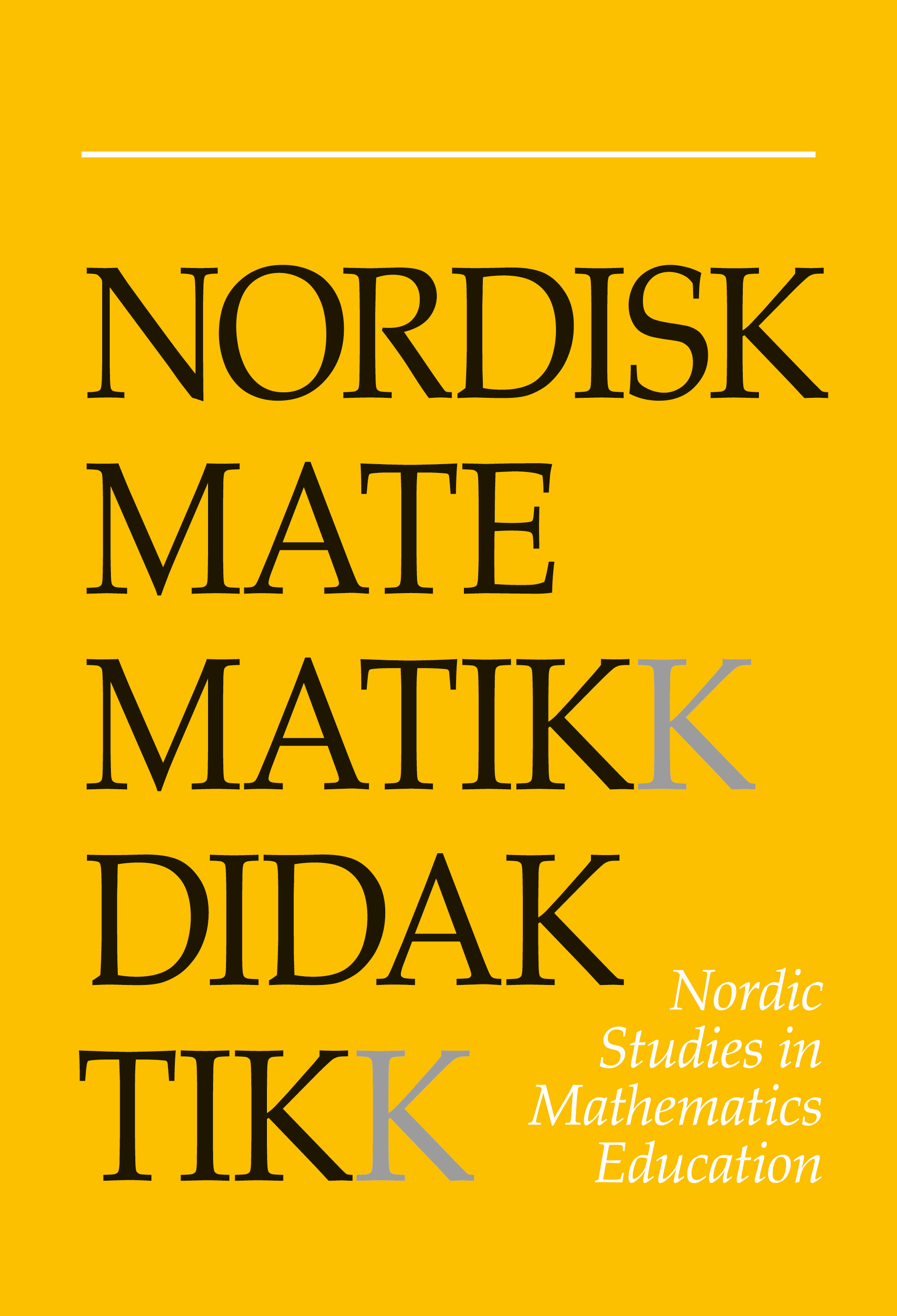Development of students’ concept images in analysis
DOI:
https://doi.org/10.7146/nomad.v14i4.148215Abstract
Students’ pre-knowledge and conceptual development in analysis were investigated at a teacher education program to reveal what pre-knowledge endured and how the students perceived the concepts a year after the course had ended. Questionnaires and interviews were used to collect data. Two students’ results are presented in more detail in the article. The study was cognitively framed with the influence of situated theories to take as many aspects of concept development into account as possible. The students showed numerous connections between concepts, but they were often unable to discern valid links from invalid links. The perceived richness from many connections causes unjustifiably strong self-confidence which prevents further work with the concept. A tool for classification of the students’ connections between concepts resulted from the analysis.
References
Aspinwall, L., Shaw, K. & Presmeg, N. (1997). Uncontrollable mental imagery: graphical connections between a function and its derivative. Educational Studies in Mathematics 33, 301-317. https://doi.org/10.1023/A:1002976729261
Cornu, B. (1991). Limits. In D. Tall (Ed.), Advanced mathematical thinking (pp. 153-166). Dordrecht: Kluwer Academic Publishers. https://doi.org/10.1007/0-306-47203-1_10
Dubinsky, E. (1991). Reflective abstraction in advanced mathematical thinking. In D. Tall (Ed.), Advanced mathematical thinking. Dordrecht: Kluwer Academic Publishers.
Gray, E. & Tall, D. (1994). Duality, ambiguity and flexibility: a procedural view of simple arithmetic. The Journal for Research in Mathematics Education 26 (2), 115-141. https://doi.org/10.2307/749505
Hiebert, J & Lefevre, P. (1986). Conceptual and procedural knowledge in mathematics: an introductory analysis. In J. Hiebert (Ed.), Conceptual and procedural knowledge: the case of mathematics. London: Lawrence Erlbaum Associates publishers.
Hähkiöniemi, M. (2006). The role of representations in learning the derivative (Doctoral thesis). University of Jyväskylä.
Juter, K. (2005). Students' attitudes to mathematics and performance in limits of functions. Mathematics Education Research Journal, 17 (2), 91-110. https://doi.org/10.1007/BF03217417
Juter, K. (2006a). Limits of functions - university students' concept development (Doctoral thesis). Department of Mathematics, Luleå University of Technology.
Juter, K. (2006b). Limits of functions as they developed through time and as students learn them today, Mathematical Thinking and Learning, 8 (4), 407-431. https://doi.org/10.1207/s15327833mtl0804_3
Juter, K. (2009). Learning analysis: students' starting point. In C. Winsløw (Ed.), Nordic Research in Mathematics Education - Proceedings from NORMA08 in Copenhagen, April 21-April 25, 2008 (pp. 127-134). Rotterdam: Sense Publishers. https://doi.org/10.1163/9789087907839_019
Merenluoto, K. & Lehtinen, E. (2004a). Number concept and conceptual change: towards a systemic model of the processes of change. Learning and Instruction, 14, 519-534. https://doi.org/10.1016/j.learninstruc.2004.06.016
Merenluoto, K. & Lehtinen, E. (2004b). The quality of conceptual change in mathematics, the case of number concept. Nordic Studies in Mathematics Education, 9 (2), 145-163.
Kilpatrick, J., Swafford, J. & Findell, B. (Eds.) (2001): Adding it up: helping children learn mathematics. Washington, DC: National academy press.
Pinto, M. & Tall, D. (2001). Following student's development in a traditional university classroom. In M. van den Heuvel-Panhuizen (Ed.), Proceedings of the 25th conference of the International Group for the Psychology of Mathematics Education (pp. 57-64). Utrecht: The Netherlands.
Sirotic, N. & Zazkis, R. (2007). Irrational numbers: the gap between formal and intuitive knowledge. Educational Studies in Mathematics, 65, 49-76. https://doi.org/10.1007/s10649-006-9041-5
Skemp, R. R. (1976). Relational understanding and instrumental understanding. Mathematics Teaching, 77, 20-26.
Smith, J. P., diSessa, A. A. & Rochelle, J. (1993). Misconceptions reconceived: a constructivist analysis of knowledge in transition. The Journal of the Learning Sciences, 3 (2), 115-163. https://doi.org/10.1207/s15327809jls0302_1
Tall, D. (1991). The psychology of advanced mathematical thinking. In D. Tall (Ed.), Advanced mathematical thinking (pp. 3-24). Dordrecht: Kluwer Academic Publishers. https://doi.org/10.1007/0-306-47203-1
Tall, D. (2004). Thinking through three worlds of mathematics. In M. Johnsen Høines & A. B. Fugelstad (Eds.), Proceedings of the 28:th conference of the International Group for the Psychology of Mathematics Education (pp. 281- 288). Norway: Bergen University College.
Tall, D. (2008). The transition to formal thinking in mathematics. Mathematics Education Research Journal, 20 (2), 5-24. https://doi.org/10.1007/BF03217474
Tall, D. & Vinner, S. (1981). Concept image and concept definition in mathematics with particular reference to limits and continuity. Educational Studies in Mathematics, 12, 151-169. https://doi.org/10.1007/BF00305619
Viholainen, A. (2008). Prospective mathematics teachers' informal and formal reasoning about the concepts of derivative and differentiability (Doctoral thesis). University of Jyväskylä.
Vinner, S. (1997). The pseudo-conceptual and the pseudo-analytical thought processes in mathematics learning. Educational Studies in Mathematics, 34, 97-129. https://doi.org/10.1023/A:1002998529016
Vosniadou, S. (1994). Capturing and modeling the process of conceptual change. Learning and Instruction 4, 45-69. https://doi.org/10.1016/0959-4752(94)90018-3
Vosniadou, S. (2007). The cognitive-situative divide and the problem of conceptual change. Educational Psychologist, 42 (1), 55-66. https://doi.org/10.1080/00461520709336918
Weber, K. (2004). Traditional instruction in advanced mathematics courses: a case study of one professor's lectures and proofs in an introductory real analysis course. Journal of Mathematical Behavior, 23, 115-133. https://doi.org/10.1016/j.jmathb.2004.03.001
Williams, S. (1991). Models of limit held by college calculus students. Journal for Research in Mathematics Education, 22 (3), 219-236. https://doi.org/10.2307/749075
Downloads
Published
How to Cite
Issue
Section
License

This work is licensed under a Creative Commons Attribution-NonCommercial-ShareAlike 4.0 International License.



